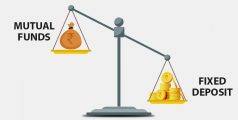
Fixed Deposit & Recurring Deposit – Differences & Similarities
Posted on Friday, June 30th, 2023 | By IndusInd Bank
There are several differences and similarities between an FD and RD. Which one you opt for depends largely on your personal financial needs and goals.
Risk-free investments provide guaranteed returns and can effectively optimise your savings. Fixed Deposits (FDs) and Recurring Deposits (RDs) are ideal investment avenues for individuals seeking stable returns without risk. All major banks and financial institutions offer these fixed-income products. You can secure a fixed interest rate by investing money in either scheme. However, selecting between the RD and FD scheme can often be confusing for investors.
This blog will give you an overview of FDs and RDs, highlighting their differences and similarities. Keep reading to understand better and determine the most suitable option.
What Is a Fixed Deposit Account?
A fixed deposit is an investment option to save and grow your money by investing a certain amount for a specified period at a predetermined interest rate. You are merely required to make a one-time deposit at the beginning of the tenure and let your money grow.
What Is a Recurring Deposit Account?
A recurring deposit account is an investment option for people with a regular income. With this type of account, you can deposit a fixed amount of money on a monthly basis and earn interest on your savings over time.
Similarities Between FD and RD
- Fixed Income Investments: FDs and RDs cater to individuals who want to earn a fixed return on their investment within a pre-decided time frame.
- Low Risk: These investment options are regarded as low-risk compared to alternatives, such as stocks or mutual funds.
- Guaranteed Returns: The potential investment returns can be determined using RD or FD calculators. Input the deposit amount, tenure, and interest rates to estimate the maturity amount.
Major Differences Between FD and RD
| Fixed Deposit | Recurring Deposit |
| Investors can make a one-time investment in an FD account for a fixed tenure. | Investors can invest a fixed amount each month in the RD account. |
| The minimum tenure for an FD account is 7 days and the maximum is 10 years. | The minimum tenure for an RD account is 12 months and the maximum is 10 years. |
| The investment amount can range from Rs. 10,000 to Rs. 10 lakhs | The investment amount varies from Rs. 500 to Rs. 2 crores. |
| A five-year FD provides income tax benefits. | Income tax benefits are not available for an RD account. |
| Interest pay-outs can be made monthly, quarterly, half-yearly, yearly, or at maturity. | The interest is only paid at the end of the tenure. |
Open an FD or RD account with IndusInd Bank
If you want to avail attractive FD rates at a bank, book an FD account at IndusInd Bank through a 100% online 3-step application process. With an IndusInd Bank fixed deposit, you can enjoy best-in-class interest rates, flexible tenure options, and choice of receiving interest pay-outs on a monthly, quarterly, half-yearly, or annual basis – or, at the time of maturity.
Alternatively, if you prefer to save money systematically every month, you can open an RD account at IndusInd Bank. By making regular monthly deposits, you can benefit from attractive returns. Starting an RD with IndusInd Bank requires a minimum investment of Rs. 500 for a tenure ranging from 1 year to 10 years.
It is important to make a careful comparison of the above-mentioned factors in order to select the right investment scheme that aligns with your financial requirements and goals. Choose wisely!
Disclaimer: The information provided in this article is generic in nature and for informational purposes only. It is not a substitute for specific advice in your own circumstances. Hence, you are advised to consult your financial advisor before making any financial decision. IndusInd Bank Limited (IBL) does not influence the views of the author in any way. IBL and the author shall not be responsible for any direct/indirect loss or liability incurred by the reader for taking any financial decisions based on the contents and information.



 Offers
Offers Rates
Rates Debit Card Related
Debit Card Related Credit Card Related
Credit Card Related Manage Mandate(s)
Manage Mandate(s) Get Mini Statement
Get Mini Statement
 categories
categories Bloggers
Bloggers Blog collection
Blog collection Press Release
Press Release


